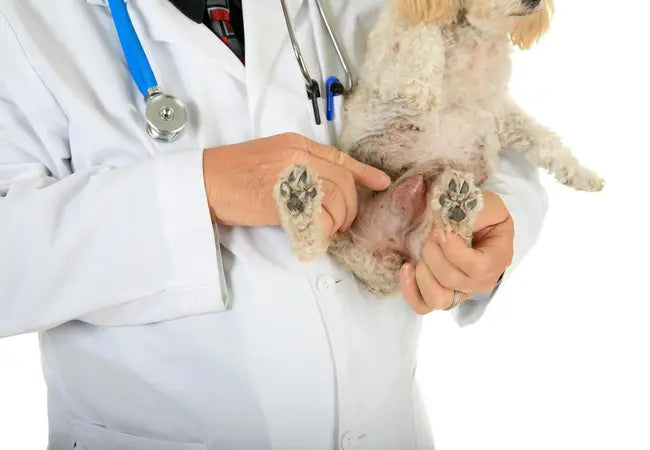Canine Vaginal Tumors in 2025 Vet Guide: Diagnosis, Treatment & Prevention🐾🩺

In this article
2025 Vet Guide: Canine Vaginal Tumors 🐾🩺
By Dr. Duncan Houston BVSc
Greetings, attentive pet parents! I’m Dr Duncan Houston BVSc. In this comprehensive 2025 guide, we'll explore vaginal and vulvar tumors in dogs—from common benign growths to rarer malignant cancers. We’ll cover types, causes, signs, diagnostic pathways, treatments (including surgery, spay, and veterinary oncology), recovery, and how Ask A Vet, can support you and your pup every step of the way 💛.
1. What Are Vaginal & Vulvar Tumors?
Vaginal and vulvar tumors are the second most common reproductive tumor in female dogs after uterine growths, comprising 2–3% of canine tumors. They arise from tissues in or around the vagina and vulva.
Types include:
- Benign smooth-muscle tumors (leiomyomas/fibroleiomyomas): ~75–86% of cases.
- Other benign masses: lipomas, fibromas, polyps, sebaceous adenomas.
- Malignant tumors: squamous cell carcinoma, adenocarcinoma, transmissible venereal tumor (TVT), mast cell tumors, hemangiosarcoma (rare).
2. Who’s at Risk?
- Older intact females—often middle-aged to senior.
- Breeds: Boxers may have higher risk for fibroid tumors.
- Hormonal influence: Estrogen may promote leiomyoma growth.
- Spayed dogs: May still get tumors, but these are more likely malignant and less common.
3. Signs to Watch For 🩺
Many vaginal tumors are found incidentally during exam. When symptoms are present, they include:
- Vulvar discharge—blood-tinged, pus-like, or mucous.
- Visible vaginal mass or protrusion.
- Excessive vulvar licking, odor, or irritation.
- Difficulty urinating or defecating (straining, dysuria, tenesmus).
- Swelling of the perineal or vulvar area.
- General signs: lethargy, appetite loss if tumors cause systemic illness.
4. Diagnostic Workflow 🔍
A thorough diagnosis ensures accurate treatment:
- History & physical exam: Focus on reproductive health, discharge, heat cycles, and palpation of masses.
- Bloodwork & urinalysis: Detect infection, hormonal imbalance, or systemic effects.
- Imaging: Abdominal ultrasound or X-rays; CT/MRI when evaluating deep or complex masses.
- Vaginoscopy or cystourethroscopy: Direct internal visualization and biopsy sample collection.
- Cytology and biopsy: Definitive tumor classification—benign vs malignant.
- Staging: Chest and abdominal imaging to check for metastasis (especially in malignant cases).
5. Treatment Options in 2025 🛡️
a) Surgical Excision + Spay
Complete removal of the tumor with concurrent ovariohysterectomy is ideal—addressing hormonal drivers and preventing recurrence. Benign masses respond very well, with recurrence rare if removal is clean.
b) Radical Vulvovaginectomy
For large, infiltrative, or malignant tumors such as SCC or adenocarcinoma, extensive surgery may be required.
c) Adjunctive Therapy
- Radiation therapy: Used when complete surgical margins are challenging, or for malignant tumors.
- Chemotherapy: Recommended for high-risk malignancies (mast cell, TVT) or metastatic disease. TVT responds excellently to vincristine/vinblastine.
6. Prognosis & Follow-Up 📅
| Tumor Type | Prognosis | Follow-Up |
|---|---|---|
| Leiomyoma/Fibroleiomyoma | Excellent with surgery—recurrence is uncommon | Check-ups every 6–12 months |
| Other Benign (fibroma, lipoma) | Excellent with removal | Routine monitoring |
| SCC, Adenocarcinoma, MCT | Guarded; depends on stage, margins, and response to adjunct therapy | Staging ± imaging every 3 months for 1 year |
| TVT | Excellent with chemo—usually curative | Monitor for lymph node enlargement |
7. Recovery & Supportive Care 🏡
- Post-op pain management: NSAIDs/opioids
- Keep surgical site clean; prevent licking with an e‑collar
- Soft diet after perineal surgery to aid elimination
- Monitor urination and bowel function
- Ensure follow-up exams and imaging as recommended
8. Preventive Measures 🛡️
- Spay before first heat: Prevents estrogen-driven tumors and pyometra.
- Early detection: Examine vulva and perineal region routinely.
- Prompt vet checks for discharge, masses, or urination issues.
9. How Ask A Vet 🛠️
- Ask A Vet: 24/7 access for post-op care advice, wound checks, and urgent symptom guidance.
10. Emotional & Community Support ❤️
Diagnosing and treating reproductive tumors can be stressful. Ask A Vet provides emotional reassurance and clarity during each decision. help ease daily routines with comfort and care tailored to recovery. Connect with online communities to share stories and support—you’re never alone in this journey.
11. Final Thoughts
Vaginal and vulvar tumors in dogs are uncommon but mostly benign and treatable. With proper diagnosis (imaging and biopsy), surgical removal—and spay with each case—outcomes are excellent. Rare cancers may require more advanced treatment and careful follow-up, but even these have potential. By combining veterinary care with tools from Ask A Vet,your pet receives comprehensive support—physically and emotionally—for the best possible outcome 🐕✨.
— Dr Duncan Houston BVSc
For trusted guidance and expert care, visit AskAVet.com and download the Ask A Vet app today!






